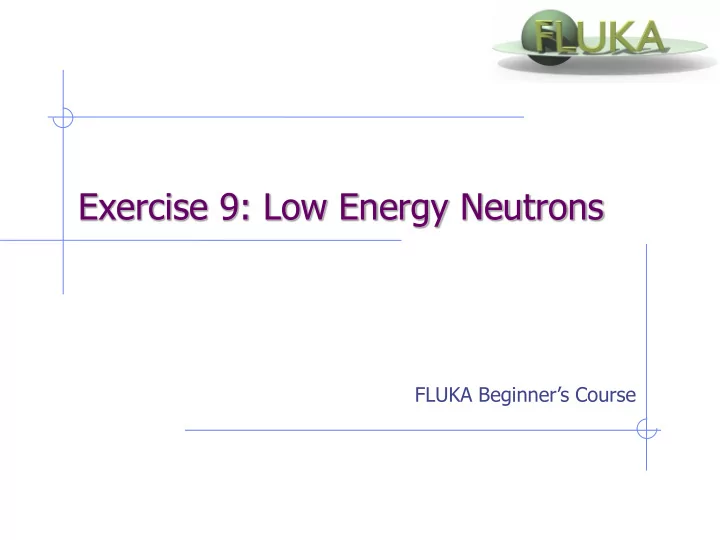

Exercise 9: Low Energy Neutrons FLUKA Beginner’s Course
Exercise 9: Low Energy Neutrons Aim of the exercise: 1- More geometry practice 2- Use of Conditional Directives 3- Run parallel cases 4- See FLUKA capabilities on low energy neutrons 2
Exercise 9: Low Energy Neutrons Start from the solution of ex5 (copy both inp and flair files): mkdir ex9 ; cp ex5/ex5.* ex9/. ; cd ex9 Geometry modifications: o Increase TARGS2 size moving T2seg plane to z=9 cm o Squeeze TARGS3 to 100 microns moving ZThigh to z=9.01 cm 3
Exercise 9: Low Energy Neutrons Material modifications: TARGS2 -> Water TARGS1 -> Lead TARGS1 -> Lead TARGS2 -> Water TARGS3- > Iron/Cadmium (use #if … #else … # endif) NB: Cd is not a FLUKA predefined material MATERIAL cast must be defined (you can try to use Flair to add it) TARGS2 -> Iron/Cadmium 4
Exercise 9: Low Energy Neutrons Add boundary crossing scoring from TARGS3 to INAIR Estimate neutron fluence (unformatted output on unit 53) Use log energy binning down to the lowest energy group For both Fe and Cd: run 5 cycles, 20000 primaries each WARNING: do not overwrite results when running the 2nd case, create two runs in Flair and run them independently Add new a run Set primaries Rename a run Set the flag(s) 5
Exercise 9: Low Energy Neutrons Plot the results as a lethargy spectrum (x-axis: GeoMean, y-axis: Y*<Xgeo>, both log axis) For the Iron case: Identify the peak in thermal part of the spectrum Note the automatic matching of neutron group structure Compare with the results obtained in the Cadmium case 6
Recommend
More recommend